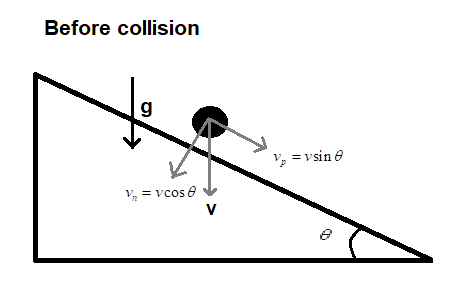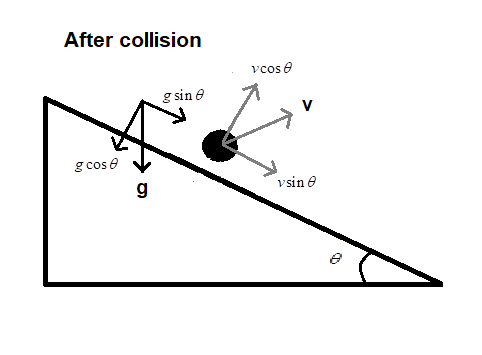
A ball falls on an inclined plane of inclination
Answer
430k+ views
Hint: In questions like this, always make the use of the three kinematic equations. If projectile motion is involved, then divide the velocity into its component then analyse each component separately. Both components will have one quantity in common i.e. time. Dealing with the motion in one dimension is easier than two-dimensional motion.
Complete step-by-step answer:
Let the ball start its motion at time t=0. The force of gravity will accelerate it. Therefore, it will come down with an acceleration of g i.e. acceleration due gravity. Let its velocity just before hitting the plane be ‘v’. Let us first calculate the value of this velocity. Use the kinematic equation,
The velocity of the ball just before hitting the plane is

Now, divide this velocity into its components such that one component is normal to the plane (say vn) and the other component is along the plane (say vp). After using geometry, we can see that

Now, the ball has a velocity whose components are
The original ball will hit the plane again when the ball B2 hits the plane again. Let us calculate the time it takes for B2 to hit the plane again. Use the displacement equation,
Therefore,
Take
Therefore,
Therefore,
Let us continue with
Take t as a common term.
That means the original ball takes a time of
Again use the displacement equation,
Therefore,
From the equation we know that
Therefore, the ball will hit the place again at a distance of
Note: For calculating the velocity of the ball just before hitting the plane, we can also use the work energy theorem. Work energy theorem states that the amount of work done on a body is equal to the change in kinetic energy of the body. The ball came down in the direction of the gravitational force (mg) for a displacement of ‘h’. Therefore, work done by the gravity is
Therefore,
Complete step-by-step answer:
Let the ball start its motion at time t=0. The force of gravity will accelerate it. Therefore, it will come down with an acceleration of g i.e. acceleration due gravity. Let its velocity just before hitting the plane be ‘v’. Let us first calculate the value of this velocity. Use the kinematic equation,
The velocity of the ball just before hitting the plane is

Now, divide this velocity into its components such that one component is normal to the plane (say vn) and the other component is along the plane (say vp). After using geometry, we can see that

Now, the ball has a velocity whose components are
The original ball will hit the plane again when the ball B2 hits the plane again. Let us calculate the time it takes for B2 to hit the plane again. Use the displacement equation,
Therefore,
Take
Therefore,
Therefore,
Let us continue with
Take t as a common term.
That means the original ball takes a time of
Again use the displacement equation,
Therefore,
From the equation we know that
Therefore, the ball will hit the place again at a distance of
Note: For calculating the velocity of the ball just before hitting the plane, we can also use the work energy theorem. Work energy theorem states that the amount of work done on a body is equal to the change in kinetic energy of the body. The ball came down in the direction of the gravitational force (mg) for a displacement of ‘h’. Therefore, work done by the gravity is
Therefore,
Latest Vedantu courses for you
Grade 11 Science PCM | CBSE | SCHOOL | English
CBSE (2025-26)
School Full course for CBSE students
₹41,848 per year
Recently Updated Pages
Master Class 11 Economics: Engaging Questions & Answers for Success

Master Class 11 Business Studies: Engaging Questions & Answers for Success

Master Class 11 Accountancy: Engaging Questions & Answers for Success

Master Class 11 English: Engaging Questions & Answers for Success

Master Class 11 Computer Science: Engaging Questions & Answers for Success

Master Class 11 Maths: Engaging Questions & Answers for Success

Trending doubts
State and prove Bernoullis theorem class 11 physics CBSE

1 ton equals to A 100 kg B 1000 kg C 10 kg D 10000 class 11 physics CBSE

State the laws of reflection of light

One Metric ton is equal to kg A 10000 B 1000 C 100 class 11 physics CBSE

Difference Between Prokaryotic Cells and Eukaryotic Cells

1 Quintal is equal to a 110 kg b 10 kg c 100kg d 1000 class 11 physics CBSE




